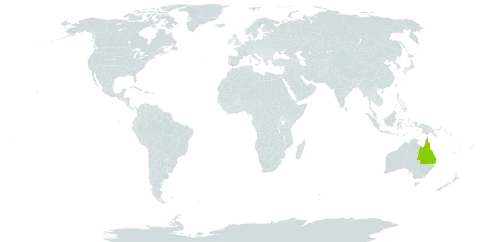Herb 14–38 cm high, perennial, tussock-forming. Leaves lanceolate, 12.0–22.2 cm long, 12–18 mm wide, 13-or 14-nerved, acuminate. Peduncle 13–41 cm long, with 7–9 ribs. Sheath 40–116 mm long. Flower heads cylindrical to hemispherical, 4–8 mm long, 5–10 mm wide. Involucral bracts cream to brown, broadly ovate, 1.7–2.5 mm long, 1.5–2.0 mm wide, obtuse, glabrous, sterile, reflexed at maturity. Floral bracts hyaline, cream to brown, spathulate-oblanceolate, cucullate, 1.7–2.5 mm long, 0.8–1.5 mm wide, subacute, dense hairs present on margins and abaxial surface. Receptacle glabrous, broadly conical to globular. Male flowers 2.3–3.0 mm long, dimorphic frequently with smaller flowers with larger anthers towards centre; sepals 3, free, hyaline, dimorphic with one smaller, spathulate to oblanceolate and hooded at apex, 1.5–1.8 mm long, 0.3–0.5 mm wide, subacute, dense white hairs on margins and abaxial surface of sepals; median sepal 1.2–1.5 mm long, 0.3–0.4 mm wide; petals 3, hyaline, dimorphic with one larger and two slightly smaller, elliptic to ovate, acute or obtuse, pubescent with sparse to dense white hairs on margins and abaxial surfaces; stamens 6; anthers black. Female flowers: sepals 3, sometimes with hyaline margins, dimorphic, laterals navicular, 1.1–2.4 mm long, 0.3–1.0 mm wide, acute, with thick and fleshy dorsal keel without hyaline margins, lamina abruptly narrowing to a long narrowly winged stipe sometimes with auricles at point of narrowing, dense white hairs on margins and keels and abaxial surfaces of petals; median sepal narrowly linear spathulate, 1.1–1.5 mm long, 0.3 mm wide; petals 3, dimorphic slightly in size only, narrowly linear oblanceolate, 1.3–2.1 mm long, 0.3–0.58 mm wide, subacute, sparse to dense white hairs, on margins and abaxial surfaces of petals; ovary 3-locular. Seeds ellipsoid, c. 0.6–0.7 mm long, 0.4–0.5 mm wide; epidermal cell outline faint and with obscure peg-like projections on transverse walls.
